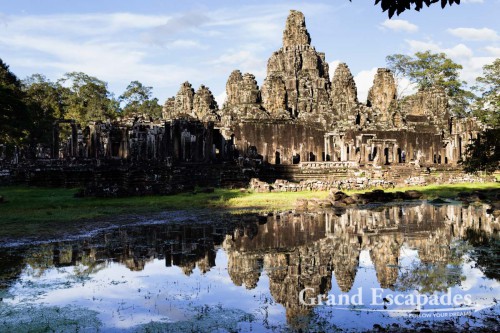Between the 12th and the 16th century, Angkor Thom was the capital of the mighty Khmer Empire. The outer enclosure is still intact and encompasses the 9 square kilometers of what was once a striving city of an estimated one million people. At that time probably the most populated place in the world!
The few monuments left are truly amazing in what is now mainly a forested area, especially the colossal Bayon temple with its 37 spectacular face-towers and the causeways leading up to the city gates that once crossed a moat. Both sides of the bridge are lined with large stone statues holding a giant snake with its typical fan-like head at the end. One side depicts demons, the other side gods.
The unscrupulous robbers, who cut off the heads of these statues, did not differentiate between god and evil. They simply stole them all. Only the south gate is relatively intact. This is why most tourists approach through this one. We left through another gate, where all the heads had been stolen. Angkor’s ornaments have been stolen since serious restoration started at the beginning of the 20th century, but it climaxed in the 1980s. Despite tough control nowadays, even now tourists are caught carrying off stones in their backpacks.
The Bayon is a monumental construction most famous for its face-towers. Each features four large faces carved from the rocks pointing in each cardinal direction. Once inside, you are lost in a maze of galleries on different levels. Many are decorated with intricate bas-reliefs narrating daily life and Khmer history.
Of course, nobody leaves Angkor Thom without strolling along Elephant Terrace with its giant elephant carvings and the Leper King Terrace with even more elaborate carvings.
Nothing is left of the royal palace or the other buildings that once constituted the city, since they were constructed from less durable material than religious buildings.


No comments yet.